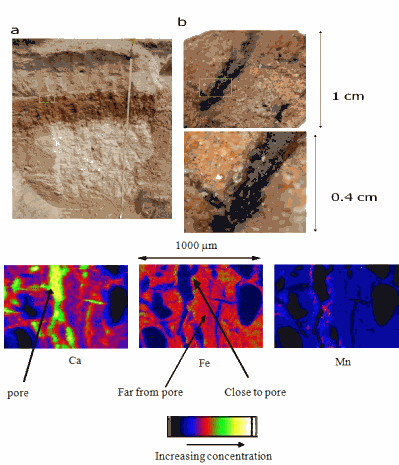Roots growing in hostile soils use previous root channels as preferential pathways when they cannot penetrate through the subsoil. Root proliferation in the subsoil facilitates access to water, since subsoil has a higher water-holding capacity. This is critical for crops in low-rainfall areas. But do the roots follow the old channels only because they offer the path of least resistance or are they chemically superior to the surrounding soil? It is well known that roots alter the chemical composition of the rhizosphere by taking up particular ions and releasing exudates, but do these features persist in a soil after the roots decay? Using the U.S. Department of Energy’s Advanced Photon Source (APS) at Argonne National Laboratory, researchers mapped the heterogeneous chemistry of plant micropores in situ. They found that, while the chemical composition is different, chemical speciation does not vary with distance from the pore. This information can be used to better manage soils and crops in hostile environments, such as low-rainfall areas.
Previously performed bulk soil analyses revealed the chemistry of a soil on a macro scale, but not on a micro-, spatially resolved scale. “We assumed that destructive studies done before—where they scraped out several millimeters of soil and studied some chemical properties—might have missed some information because the studies ‘diluted out’ the micrometer-scale differences in nutrient concentrations and their chemistry,” said Ganga Hettiarachchi of Kansas State University, who authored the 2009 Soil Science of America Journal paper along with her student, Laurence Jassogne of the University of Western Australia, and David Chittleborough and Ann McNeill of the University of Adelaide.
Understanding the chemistry of the soil around pores and channels at the microscale requires non-invasive synchrotron-based x-ray techniques. The researchers used the x-ray fluorescence spectroscopy (XRF) microprobe at X-ray Operations and Research/PNC 20-ID beamline at the APS to map the distribution of nutrients Ca, Mn, Fe, Cu, and Zn at the micrometer scale in and around the soil pores. Using these XRF maps, the scientists located element hotspots immediately adjacent to the micropore and further into the soil matrix for µ-x-ray absorption spectroscopy (XAS) analysis. They analyzed the speciation of Mn, Fe, Cu, or Zn in the hotspots using µ-XAS (µ-x-ray absorption near edge structure and µ-extended x-ray absorption fine structure) spectroscopy.
The scientists chose duplex soils (Fig. 1), which make up about 20% of the Australian continent. Duplex soils exhibit an abrupt transition from horizon A (the top layer of a soil profile) (or E, the leached lower regions of the topmost soil layer) to horizon B immediately below horizon A, including as much as a 10-fold increase in clay content in a distance of <2 cm. The clays inhibit the growth and proliferation of plant roots and restrict water uptake. In duplex soils, 80% of roots are located in the macropore sheath, the soil surrounding a root channel, crack, or other structural void.
Nutrient enrichment/depletion around the pores was still evident: Ca was concentrated in the pores; Mn, Zn, and Cu accumulated around the micropores, and Fe was similar throughout (Fig. 2). However, XAS spectra indicated that the chemical form of the elements was no different in, near, or away from the micropore. So while Zn, Mn, and Cu are concentrated within the vicinity of the micropore, the chemical form of the elements was not different from the rest of the soil.
“This understanding can be used to manage soils in hostile environments; in other words, we could use physical and chemical amelioration of hostile subsoil as a management strategy,” said Hettiarachchi. For example, vegetation could be planted to increase the numbers of biopores in the subsoil, which would improve the structure and permeability of the subsoil, and also increase the number of preferential pathways for exploitation by roots of subsequent vegetation. — Dana Desonie
See: Laurence Jassogne1, Ganga Hettiarachchi2*, David Chittleborough3, and Ann McNeill3, “Distribution and Speciation of Nutrient Elements around Micropores,” Soil Sci. Soc. Am. J. 73(4), 1319 (July-August 2009). DOI: 10.2136/sssaj2008.0174
Correspondence: *ganga@ksu.edu
Author affiliations: 1University of Western Australia, 2Kansas State University, 3University of Adelaide
This work was supported by the Australian Synchrotron Research Program, which is funded by the Commonwealth of Australia under Major National Research Facilities Program. The CRC for plant based management of dryland salinity also partly funded this research. XOR/PNC facilities at the APS, and research at these facilities, are supported by the U.S. Department of Energy, Office of Science, Office of Basic Energy Sciences, a major facilities access grant from the Natural Sciences and Engineering Research Council of Canada, the University of Washington, Simon Fraser University, and the Advanced Photon Source.
The Advanced Photon Source is supported by the U.S. Department of Energy, Office of Science, Office of Basic Energy Sciences, under Contract DE-AC02-06CH11357.
Argonne National Laboratory seeks solutions to pressing national problems in science and technology. The nation's first national laboratory, Argonne conducts leading-edge basic and applied scientific research in virtually every scientific discipline. Argonne researchers work closely with researchers from hundreds of companies, universities, and federal, state and municipal agencies to help them solve their specific problems, advance America's scientific leadership and prepare the nation for a better future. With employees from more than 60 nations, Argonne is managed by UChicago Argonne, LLC for the U.S. Department of Energy's Office of Science.

